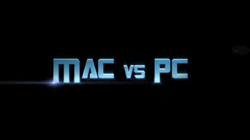 Apple continues its highly successful Mac vs. PC commercial spots with three new pieces on the themes of the “glitchy” Microsoft Vista and on-campus notebook computer sales. These catchy ads—with their ambiguously facial-haired Mac guy and their unambiguous PC dork—have spawned hundreds of YouTube imitators with views adding up to tens of millions, at least. Practically everyone has seen the ads and knows now, through the magic of character and narrative, that Mac is cooler than PC. But has this campaign helped move the needle?
Apple continues its highly successful Mac vs. PC commercial spots with three new pieces on the themes of the “glitchy” Microsoft Vista and on-campus notebook computer sales. These catchy ads—with their ambiguously facial-haired Mac guy and their unambiguous PC dork—have spawned hundreds of YouTube imitators with views adding up to tens of millions, at least. Practically everyone has seen the ads and knows now, through the magic of character and narrative, that Mac is cooler than PC. But has this campaign helped move the needle?
Though the commercials imply it, are Mac sales outstripping PC sales? Not even close. Apple owns about 3-4% of the personal computer market, with Windows-based PCs taking the overwhelming majority of the rest of it.
However, since May 2006, when the campaign launched, Mac sales have skyrocketed, moving from about 1.3 million units a quarter to 2.3 million units in the first quarter of 2008. Similarly, Apple’s personal computer market share increased from 2.5% to 3.5% over that same period.
So how’d they do it? Characters.
Brands are like people. They have stories, personalities, and can interact with each other and with other brands similarly to how people interact with each other. Apple had the guts to reduce their very dynamic and complicated product into one T-shirt wearing guy. (This is not an endorsement of Macs; PCs are equally dynamic and complicated.) It was probably a much easier pill to swallow to reduce the competitor to a stodgy, aviator-glasses-wearing nerd.
To see why a brand would be afraid to do this is simple. Marketers don’t want to pigeonhole their product into one thing that their prospective customers may or may not have affinity with. Allowing that fear to prevent a marketer from doing something like this points to a very common marketer mistake: Looking at people as types and not people. People—even the most boring, anemic people—are far more dynamic and complicated than any computer, or any product or brand, for that matter.
Great characters tell great stories with their very existence. Read the first rule of the post-advertising age in big, upper-case letters to your right: IN THE POST-ADVERTISING AGE, THE BRANDS THAT TELL THE BEST STORIES WIN.
Enjoy the new spots:
Here is a link to a host of Mac vs. PC parodies.



Pingback: Latest Iteration of Crispin Porter + Bogusky's Ads for Microsoft Are...I Just Don't Care | Post Advertising